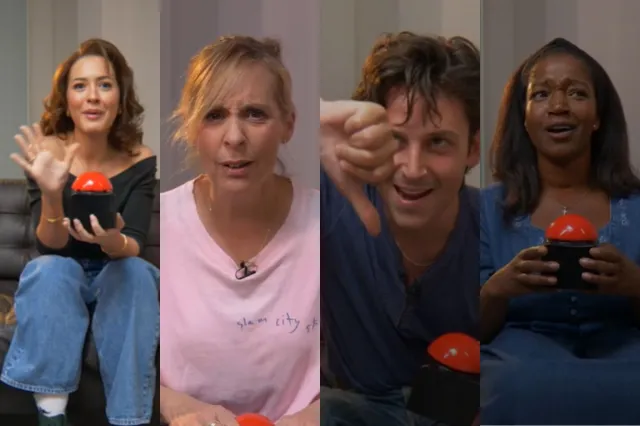Jeeves and Wooster in Perfect Nonsense
The first stage appearance of Jeeves and Wooster provides an evening of Wodehousian West End fun
The relationship between silly chump Bertie Wooster and his inscrutable, unflappable manservant Jeeves is based on the latter saving the former in a succession of scrapes, social faux pas, linguistic minefields and sartorial blunders.
Translating that energy into a performance format proves a rum old business: this new three-hander by Robert and David Goodale, hyper-inventively directed by Sean Foley, goes down the route of meta-theatricality, laying a sort of 39 Steps approach across the improvisatory template of The Play What I Wrote.
Stephen Mangan‘s red-jacketed Wooster, baring his teeth and braying like a demented donkey, is therefore lumbered with an audience to whom, on an empty and under-populated stage, he is obliged to recount a drastically filleted but basically accurate version of P G Wodehouse’s 1938 comedy classic The Code of the Woosters.
Our hero, attended and supported by Matthew Macfadyen‘s suave and pale-featured Jeeves, must therefore decamp from Berkeley Square to Totleigh Towers, Glos, retrieve a silver cow-creamer for Aunt Dahlia and salvage the impending nuptials of best pals Gussie Fink-Nottle and Madeline Bassett, while staving off the intrusions of the dastardly crypto-fascist Roderick Spode.
The show’s brilliant joke is that the implacable Jeeves, whose interventions are only implied at leisure in the original, is translated into a quick-change artist in the cause of smoothing out the creases, and the crises, in the story.
The joke is admittedly diluted in the necessity of a back-up player, the squirrely servant Seppings, played by a grumpy little Mark Hadfield, playing all the parts Jeeves can’t quite reach. But the manoeuvre also provides a clever variation on the delirious dynamic of Toby Jones’ third party sucker in The Play What I Wrote, dividing the responsibility of role-playing and gradually defining Bertie as the real outsider in his own narrative.
Macfadyen’s blank canvas – this strikingly good-looking Jeeves avoids both the oleaginous creepiness of Dennis Price and the eccentric muttering of Michael Hordern – is vividly occupied not only by a goggle-eyed Gussie, but also by an absurdly seductive Madeline (in a lampshade and half a curtain), as well as her father Sir Watkyn (white bushy hairpiece and thrusting pipe) and his ward, Stiffy Byng, a sort of low-rent Lauren Bacall in a purple frock.
The complications of the plot are therefore complemented in the accumulations of absurd characterisation. In one scene, pa Bassett and offspring are simultaneously occupied in a single split costume, while the baleful Seppings, ferreting around the stage like a prognathous truffle-hound, is obliged to “voice” his monumental Spode (Hitler moustache, eight-foot leather coat worn while standing on a stool or chair) with his bow-legged, taffeta-dressed Aunt Dahlia, who increasingly resembles a dismal tangerine.
Foley’s production probably errs on the side of too much scenic and stage-effects business, as if covering all options without trusting them equally. But it seems churlish to complain about a show that is so fertile and generous in its presentation, and so spiritedly performed. It just needs a little more settling down, and a little more light and shade, so the audience doesn’t feel “got at” all the time. And no, I don’t think we misheard Harold “Stinker” Pinker as Harold Pinter, did we?
The sets and costumes are the outstanding work of Alice Power, and there’s even a curtain-call bonus, a la Shakespeare’s Globe, with a brilliantly executed Charleston trio, choreographed by Carrie-Anne Ingrouille. Crikey, Jeeves, how did we all do that?












